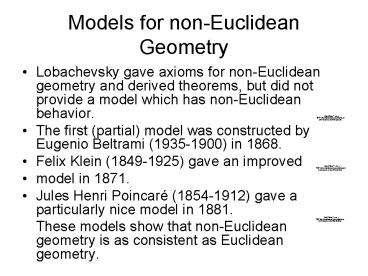Models for nonEuclidean Geometry - PowerPoint PPT Presentation
1 / 12
Title:
Models for nonEuclidean Geometry
Description:
... Euclidean Geometry ... axioms for non-Euclidean geometry and derived theorems, but ... show that non-Euclidean geometry is as consistent as Euclidean geometry. ... – PowerPoint PPT presentation
Number of Views:89
Avg rating:3.0/5.0
Title: Models for nonEuclidean Geometry
1
Models for non-Euclidean Geometry
- Lobachevsky gave axioms for non-Euclidean
geometry and derived theorems, but did not
provide a model which has non-Euclidean behavior.
- The first (partial) model was constructed by
Eugenio Beltrami (1935-1900) in 1868. - Felix Klein (1849-1925) gave an improved
- model in 1871.
- Jules Henri Poincaré (1854-1912) gave a
particularly nice model in 1881. - These models show that non-Euclidean geometry is
as consistent as Euclidean geometry.
2
Jules Henri Poincaré(1854- 1912)
- Born 29 April 1854 in Nancy, Lorraine,
FranceDied 17 July 1912 in Paris, France - Founded the subject of algebraic topology and the
theory of analytic functions. Is cofounder of
special relativity. - Also wrote many popular books on mathematics and
essays on mathematical thinking and philosophy. - Became the director Académie Francaise and was
also made chevalier of the Légion d'Honneur . - Author of the famous Poincaré conjecture.
3
The Poincaré Disc Model
- Points The points inside the unit disc D(x,y)
x2y2lt1 - Lines
- The portion inside D of any diameter of D.
- The portion inside the unit disc of any Euclidean
circle meeting C(x,y) x2y2lt1 at right
angles. - Angles The angles of the tangents.
4
The Poincaré Disc Model
- The distance between the points A,B is given by
- d(A,B) ln (AQ/BQ)x(BP/AP)
- This corresponds to a metric
- ds2(dx2dy2)/(1-(x2y2))2
- That means that locally there is a stretching
factor - 4/(1-(x2y2))2
Q
B
A
P
5
The Poincaré Disc Model
The lines l and l are the two Lobachevsky
parallels to l through P.
The lengths are not the Euclidean lengths
The angles are the Euclidean angles
l
P
l
l
There are infinitely many lines through the point
P which do not intersect l.
6
The Poincaré Disc Model
H
C
G
E
F
A
D
H
G
E
B
7
The Klein Model
Both the angles and the distances are not the
Euclidian ones
Lines are open chords in the open unit disc
8
Beltramis Model
The Pseudo-Sphere
Rotation of the Tractrix yields the
pseudo-sphere. This is a surface with constant
Gauss curvature K -1 Straight lines are the
geodesics cosh2 t (v c) 2k2
xsech(u)cos(v) ysech(u)sin(v) zutanh(u)
x 1/cosh(t) y t - tanh(t)
9
The Pseudo-sphere
10
The Upper Hyperboloid as a Model
z
The upper Hyperboloid x2y2-z2-1 zgt0
The light cone x2y2z2
The projection to the Poincaré disc is via lines
through the origin.
x2y21 z-1
11
The upper Half Plane
- H (x,y)ygt0
- Lines are
- Half-lines perpendicular to the x-axis
- Circles that cut the z-axis in right angles
- Angles are Euclidean
- Lengths are scaled
- ds2 (dx2 dy2)/ y2
12
The upper half plane II
- The fundamental domain for the group generated
by the transformations - T z? z1
- S z ? -1/z































